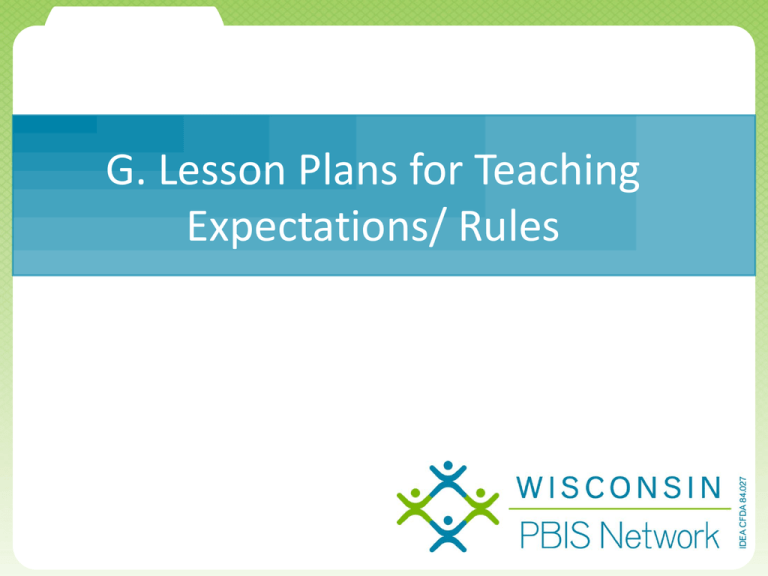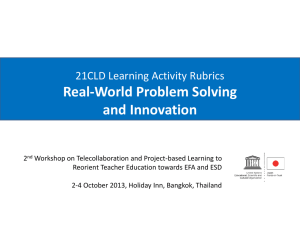Module G Lesson Plans for Teaching Expectations and Rules
advertisement

G. Lesson Plans for Teaching ClickExpectations/ to edit MasterRules title style Click to edit Master subtitle style 4/13/2015 2 Critical Element/Trainer Presentations G. Lesson Plans for Teaching Expectation/ Rules PBIS Implementation Goal Workbook Examples and Tools 29. A behavioral curriculum includes teaching expectations and rules a. Lesson plans are developed and used to teach rules and expectations Module G Snapshot Safety in the Cafeteria Assemblies 30. Lessons include examples and non-examples a. Lesson plans include both examples of appropriate behavior and examples of inappropriate behavior Cool Tool Format WI PBIS Network Web Examples Click to edit Master title style Cool Tool Template 31. 32. Lessons use a variety of teaching strategies Module G a. Lesson plans are taught using at least 3 different teaching strategies (e.g., Selfmodeling, role-playing, videotaping) Assessment and Action Plan Lessons are embedded into subject area curriculum a. Nearly all teachers embed behavior teaching into subject area curriculum on a daily basis Cool Tool for Assemblies Playground Cool Tool Ashland Tardy Video Click to edit Master subtitle style 4/13/2015 33. Faculty/staff and students are involved in development and delivery of behavioral curriculum a. Faculty, staff and students are involved in the development and delivery of lesson plans to teach behavior expectations and rules for specific settings 34. Strategies to share key features of SW-PBIS program with families/community are developed and implemented a. The PBIS Plan includes strategies to reinforce lessons with families and the community (e.g., after-school programs teach expectations, newsletters with tips for meeting expectations at home) Table Manners Cool Tool 3 Developing a System for Teaching Click to edit Master title style Appropriate Behavior Click to edit Master subtitle style 4/13/2015 4 Once you have developed school-wide expectations, it is not enough to just post the words on the walls of the classroom… YOU MUST TEACH (and RETEACH) THEM! Behavioral Errors • More often occur because: Students do edit not have appropriate skills-style “Skill Click to Master title Deficits” Students have not developed skills to fluency Students do not know when to use skills Click to edit Master subtitle style Students have not been taught specific classroom procedures and routines Skills are not taught in context 4/13/2015 6 “If a child doesn’t know how to read, we teach.” “If a child doesn’t know how to swim, we teach.” “If a child doesn’t know how to multiply, we teach.” “If a child doesn’t know how to drive, we teach.” “If a child doesn’t know how to behave, we… …teach? …punish?” “Why can’t we finish the last sentence as automatically as we do the others?” (Herner, 1998) Why Develop a System for Teaching Behavior? • Behaviors are prerequisites for academics • Procedures and routines create structure Click to edit Master title style • Repetition is key to learning new skills: • For a child to learn something new, it needs to be repeated on average of 8 times • Adults 25-Master Joyce and Showers, 2006 Clickaverage to edit subtitle style • For a child to unlearn an old behavior and replace with a new behavior, the new behavior must be repeated on average 28 times (Harry Wong) 4/13/2015 8 Why Develop a System for Teaching Behavior? • We can no longer assume: •Click Students expectations/rules and toknow edittheMaster title style appropriate ways to behave • Students will learn appropriate behaviors quickly and effectively without consistent practice and Click to edit Master subtitle style modeling 4/13/2015 9 Why Develop a System for Teaching Behavior? • We must assume: • Students will require differenttitle curricula, Click to edit Master style instructional modalities, etc… to learn appropriate behavior • We need to teach expectations/rules and appropriate behaviors as subtitle effectively as we teach Click to edit Master style academic skills 4/13/2015 10 Teaching Academics & Behaviors ADJUST for Efficiency MONITOR & ACKNOWLEDGE Continuously DEFINE Simply MODEL PRACTICE In Setting How Do We Teach Behavior? • Kick-off Events – Teaching staff, students and families the expectations and rules • On-going Direct Instruction Click to edit Master title style – Data-driven and scheduled designed lessons, character education – Pre-correction – Re-teaching immediately after behavioral errors • Embedding in Other Curriculum • Booster Trainings Click to edit Master subtitle style – Scheduled and data-driven • Continued Visibility – Visual Displays – posters, agenda covers – Daily announcements – Newsletters 4/13/2015 12 Specially Designed Lessons • Provide initial lesson plans and/or lesson plan format for teachers to begin teaching Click to edit Master title style behavior • Build on what you have (I.e. character ed.) • Develop a system for expanding behavior Clickplan to edit Master subtitlethe style lesson ideas throughout year • Determine the minimum requirements for teaching behavior (i.e. how often) 4/13/2015 13 Lesson Plans: Two Levels • Level 1: Concept Development (Expectations) – Broad expectations – Applicable to all settings Click to edit Master title style • Level 2: Skills (Rules) – Observable Click tobehaviors edit Master subtitle style – Rules for specific settings *****Lessons must be taught in setting that behavior occursFor example, if you are teaching cafeteria rules, students need to be in the cafeteria ******* 4/13/2015 14 Strategies for Success • Describe specific, observable behaviors for each expectation • Plan for modeling the desired behaviors • Provide students with written and graphic cues in the setting where the behaviors are expected • Acknowledge efforts Click to edit Master subtitle style • Plan to re-teach and restructure teaching • Allow students to participate in the development process • Use “teachable” moments that arise in core subject areas and in non-academic times Click to edit Master title style 4/13/2015 15 Why Embed Expectations into Curriculum? •Behavior curriculum does not have to be separate Click to edittime Master •Helps to eliminate crunchestitle style •Provides a rationale for students- helps students to see how the expectations fit into everyday life •Meets best practices approach Click to edit Master subtitle style -Hands on activities -Meets all learning styles (oral, visual, kinesthetic) -Higher order learning activates (synthesize, analyze, etc.) 4/13/2015 16 Embedding Expectations into Current Daily Curriculum Social Studies Click to edit Master title style •Have students research different cultures to find out how they define “Respectful” •Talk about how different historical events occurred because of conflict and come up with solutions on how the conflict have been resolved Clickcould to edit Master subtitle style 4/13/2015 17 Embedding Expectations into Current Daily Curriculum Language Arts and Reading Click to edit Master title style •Use a novel that has an expectation as a theme •Discuss characters in a novel and how they did not show respect, then have the students write the story with the character showing respect Click to edit Master style and/or •Have the students develop theirsubtitle own expectations rules and then have them write a persuasive essay or debate why theirs should be used instead of the school’s 4/13/2015 18 Embedding Expectations into Current Daily Curriculum Fine Arts (Music, Art, Computers, Graphics) Click to edit Master title style • When choosing a school play, choose one with a theme centered around one of the school expectations or write your own play • Have the students compose a song/rap with the expectation Click to edit Master subtitle style • Have students come up with a campaign for promoting expectations to the entire student body 4/13/2015 19 Embedding Expectations into Current Daily Curriculum Science and/or Math • Have students develop a hypothesis about what they think are the top behavior problems at school. Have them survey students, parents, & teachers; make graphs; and reach a conclusion about the hypothesis • Have the students count the number of tickets redeemed monthly for prizessubtitle & graph them. Click to edit Master styleYou can include ratio of number of tickets to student, # of tickets per teacher, etc. Click to edit Master title style 4/13/2015 20 What are Cool Tools? Cool tools are behavioral lesson plans that structure how staff teach the expected behaviors from the school-wide behavioral matrix. Cool Tools are: Click to edit Master title style • Research-based procedures for teaching the behaviors; • Examples and non-examples taken from classroom and non-classroom settings and situations; • Modeling and role-playing to teach new skills and provide students with practice Click to edit Master subtitle style opportunities; • Feedback and acknowledgment to ensure students display the expected/taught behaviors; • Taught weekly following kickoff and monthly following proof of fluency. 4/13/2015 21 Designing a Cool Tool Step one: Select the skill to be taught Skills are taken directly from the behavioral matrix Select skills based on the trends in your data Click to edit Master title style Step two: Write the lesson plan 1. 2. 3. 4. Name the skill & align to school-wide expectations Introduce the rule/skill Click to edit Master subtitle style Demonstrate the rule/skill Provide acknowledgment and feedback 4/13/2015 22 Cool Tools Behavioral Lesson Plan Universal Expectation: Respectful Name of the Skill/Setting: Quiet Hallways Purpose of the lesson/Why it’s important: Show respect for teachers and classmates. Minimize distractions to learning. Establish school-wide consistency and community. Click to edit Master title style Teaching Examples: Be quiet when walking in the hallway. Be quiet when taking a bathroom break or getting a drink. Be quiet when going to your locker. Kid Activities/Role-Plays: Click to edit Master subtitle style Brainstorm ways to greet friends without talking or leaving the line (smile, finger waves, etc.) Quietly walk to different locations in large and small groups. Quietly put things into and take things out of lockers. Quietly get a drink. Try to walk through the hallway as quietly as a mouse. Make and carry a classroom Quiet sign when walking through the hallways. Follow-Up Reinforcement Activities: Tico Tickets Classroom celebrations 4/13/2015 23 Cool Tools Behavioral Lesson Plan Universal Expectation: Respect Others Name of the Skill/Performance Standard: Use a quiet voice Setting: Lunchroom/cafeteria Purpose of the lesson/Why it’s important: using a quiet voice allows everyone to have a pleasant lunchtime, and have good conversations with our friends Teaching Examples: -Restaurant – loud people near you -School cafeteria – announcements Student Activities/Role-Plays: Counting 0-10 volume increases with each number Counting to predetermined voice level and practice Follow-Up Reinforcement Activities: Pre-correct prior to each lunch Wall banner for each day voice level is achieved Ashland H.S. The Tardy Project Click to edit Master title style Cool Tools - Wisconsin PBIS Network Click to edit Master subtitle style 4/13/2015 25 Activity G.1 Write Cool Tools-Behavioral Lesson Plans – In groups of 2-3, choose a behavioral skill from your matrix and write a cool tool. Click to edit Master title style Create a teaching system – How will the the staff how tostyle develop and Click to team edit teach Master subtitle deliver Cool Tools? – How will the school share the Cool Tools with Families/Communities? 4/13/2015 Cool Tool Format 26 Cool Tool Template Activity G.2 Current Practice • How does your school teach expectations? • HowClick do youto useedit “best practices” teach social Mastertotitle styleskills? – Teach directly in settings ? (i.e. bus expectations taught on bus) – Faculty and Staff Model appropriate behavior? • How would embedsubtitle into subject area Clickyou tostart editto Master style curriculum? • How will lessons be taught throughout the school year? • Review Examples 4/13/2015 27 Complete Module G. Lesson Plans for Click to edit Master title style Teaching Behavioral Skills Self Assessment and Action Plan Click to edit Master subtitle style 4/13/2015 28 Activity




